Comments / Questions (6)
![]() William J Patton wrote:
William J Patton wrote:
How to make this for a US size 16
03.11.2024 - 10:57DROPS Design answered:
Dear William, you would need to make the shoes 1 size bigger than the largest size. Take into account that the size of the shoe will depend on how you felt the yarn, since it may shrink the piece more. Start with 17 stitches, follow the marker instructions as the last size, repeat the increases 6 times and work until piece measures 23 cm. Then follow the instructions as for the largest size. The slipper should measure approx. 63cm at the end. Happy knitting!
03.11.2024 - 12:52
![]() Georges Corinne wrote:
Georges Corinne wrote:
Je viens de terminer les chaussons en taille 41-43, je suis très contente du résultat pour information, je n'ai utilisé que 4 pelotes
20.06.2024 - 14:56
![]() Georges Corinne wrote:
Georges Corinne wrote:
Bonjour, je souhaite tricoter les chaussons en taille 41-43 si j'ai 13 mailles au départ et que je fais 5 fois 2 augmentations, j'ai 23 mailles et non 33 comme indiqué de plus, dans le RANG 1 vous dites de rabattre 2 mailles, 4 points mousse, 21 mailles jersey, 6 mailles point mousse, comment arrivez-vous à 39 mailles? et donc il doit y avoir également une erreur pour le RANG 2 merci pour votre réponse
16.06.2024 - 15:29DROPS Design answered:
Bonjour Mme Goerges, vous allez augmenter 20 fous pour la pointe au total: 2 m de chaque côté de chaque marqueur, soit 4 mailles par rang d'augmentations x 5 fois = 20 augmentations + les 13 mailles montées = 33 mailles au total. Vous rabattez ensuite 2 m de chaque côté soit 31 m à la fin du rang 1 (la correction suit, merci) et 29 m à la fin du rang 2. Bon tricot!
17.06.2024 - 08:56
![]() Georges Corinne wrote:
Georges Corinne wrote:
Bonjour, Dans le matériel, vous dites qu'il faut des aiguilles no 8, et dans les explications, ce sont des aiguilles no 6... Lesquelles sont les bonnes ? Merci
31.05.2024 - 13:14DROPS Design answered:
Bonjour Mme Georges, il faut bien tricoter avec les aiguilles 8, la correction a été faite, merci pour votre retour. Bon tricot!
31.05.2024 - 16:46
![]() Pernille Solem wrote:
Pernille Solem wrote:
Hei, tovete tøfler «Moss dream» skal være 45 cm lang ved str 38/40 før toving. Det må være feil for tøffel men blir ca 10 cm for lang etter toving…Kan det være feil i oppskriften?
09.02.2024 - 15:06DROPS Design answered:
Hei Pernille, Du kan prøve å tove tøflene en gang til for å redusere størrelsen. God fornøyelse!
12.02.2024 - 08:23
![]() Hanna wrote:
Hanna wrote:
Först står det stickstrl 8 och sen 6, vilket stämmer?
29.12.2023 - 14:57DROPS Design answered:
Hej Hanna, Tak for info - Det skal være pind 8 :)
02.01.2024 - 12:24
Moss Dream#mossdreamslippers |
|
 |
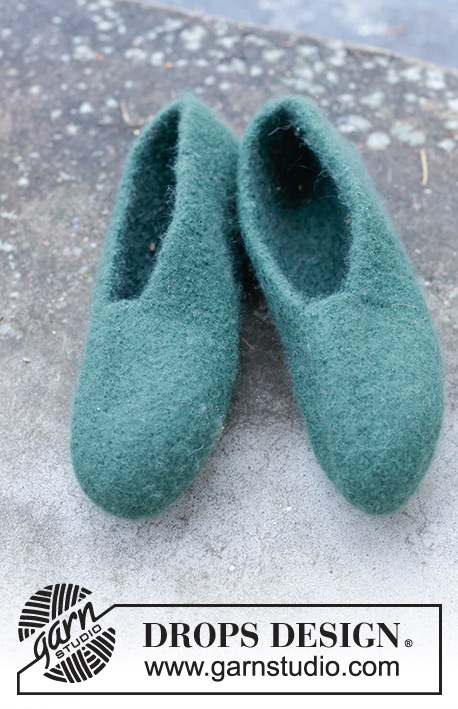 |
Knitted and felted slippers for men in DROPS Snow. The piece is worked back and forth, from toe to heel. Sizes 38-46.
DROPS 246-44 |
|
|
------------------------------------------------------- EXPLANATIONS FOR THE PATTERN: ------------------------------------------------------- GARTER STITCH (worked back and forth): Knit all rows. INCREASE TIP: Increase by making 1 yarn over from the right side, which is purled twisted on the next row to avoid a hole. ------------------------------------------------------- START THE PIECE HERE: ------------------------------------------------------- SLIPPERS - SHORT OVERVIEW OF THE PIECE: The piece is worked back and forth from toe to heel, then sewn together. SLIPPER: Cast on 13-13-15 stitches with needles size 8 mm and DROPS Snow (leave a strand-end of 50 cm, to be used when assembling). Insert 1 marker in the 3rd-3rd-4th stitch and 1 marker in the 11th-11th-12th stitch. Work stocking stitch back and forth – AT THE SAME TIME increase 1 stitch on each side of both markers – read INCREASE TIP. Increase like this every 2nd row a total of 4-5-5 times = 29-33-35 stitches. REMEMBER THE KNITTING TENSION! Work until the piece measures 19-21-21 cm. Work the next 2 rows as follows: ROW 1: Cast off 2-2-2 stitches with knit, work 4-4-4 GARTER STITCHES – read description above, 17-21-23 stocking stitches and 6-6-6 garter stitches = 27-31-33 stitches. ROW 2: Cast off 2-2-2 stitches with knit, work 4-4-4 garter stitches, 17-21-23 stocking stitches and 4-4-4 garter stitches = 25-29-31 stitches. Continue working back and forth with stocking stitch and 4-4-4 garter stitches on each side, until the piece measures 45-49-56 cm. Cast off. ASSEMBLY: Tack a strand through the stitches on the cast-on edge and tighten for the toe. Fold the slipper so the sides meet and sew together as far as the cast-off stitches on each side (mid-top of foot) – sew in the outermost loop of the outermost stitch. Fold and sew together the cast-off edge in the same way. Work the other slipper in the same way. FELTING: Place the slippers in the washing machine, using a detergent without enzymes or optical bleaches and together with a terry towel of approx. 50 x 70 cm. Wash at 40 degrees with normal centrifuge and without pre-wash – NOTE: Do not use a short programme. After washing, shape the slippers while still wet. AFTER FELTING: If the slippers are not felted enough and are too big, wash them one more time in the washing machine while still wet. If the slippers have been felted too much and are too small, stretch them to the correct measurements while still wet. If they are already dry, re-wet them before stretching. Remember: Subsequent washes are as a normal wool garment. |
|
Have you finished this pattern?Tag your pictures with #dropspattern #mossdreamslippers or submit them to the #dropsfan gallery. Do you need help with this pattern?You'll find 17 tutorial videos, a Comments/Questions area and more by visiting the pattern on garnstudio.com. © 1982-2025 DROPS Design A/S. We reserve all rights. This document, including all its sub-sections, has copyrights. Read more about what you can do with our patterns at the bottom of each pattern on our site. |
|







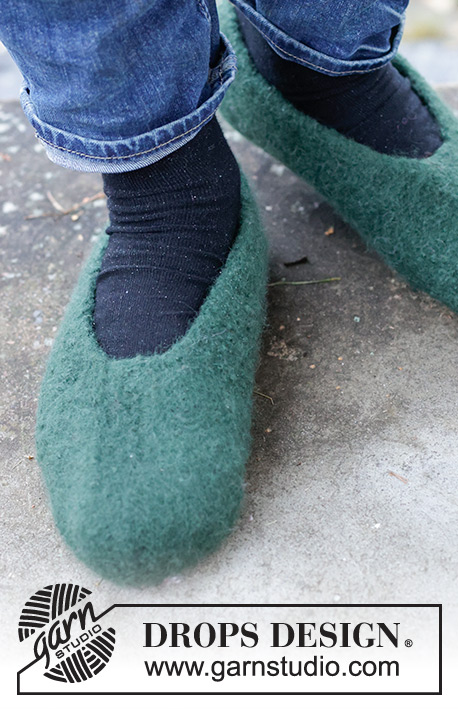
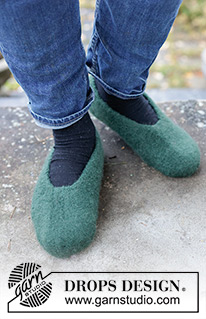

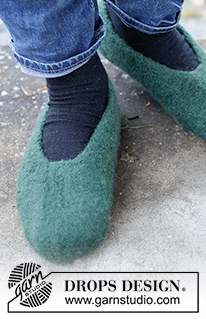





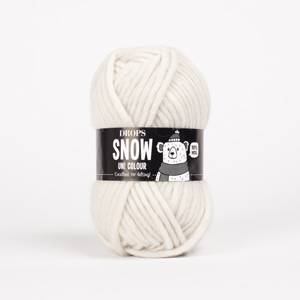



































Post a comment to pattern DROPS 246-44
We would love to hear what you have to say about this pattern!
If you want to leave a question, please make sure you select the correct category in the form below, to speed up the answering process. Required fields are marked *.